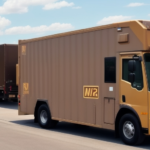Understanding Ground and Standard Shipping
When shipping products to your customers, selecting the right shipping method is crucial for balancing cost and delivery time. Two of the most popular options are ground shipping and standard shipping. While they may seem similar initially, they have distinct differences that can significantly impact your business operations.
Defining Ground Shipping
Ground shipping involves transporting packages via land, typically using trucks or trains. This method is commonly used for domestic shipping within the same country. Ground shipping is generally more affordable, making it a cost-effective option for businesses shipping larger and heavier packages that are not time-sensitive.
Defining Standard Shipping
Standard shipping encompasses a combination of transportation methods, including air, land, and sea. It is versatile and suitable for both domestic and international shipping. While standard shipping tends to be faster than ground shipping, it often comes at a higher cost. Additionally, standard shipping may offer more comprehensive tracking and insurance options, providing added security for valuable shipments.
Cost Comparison: Ground vs. Standard Shipping
The cost of shipping is a vital consideration for businesses when selecting a shipping method. Ground shipping is typically more economical due to its slower delivery times and reliance on land transportation. However, costs can increase with the size and weight of the package. In contrast, standard shipping is generally more expensive but provides faster delivery times and more shipping options. According to UPS shipping rates, ground shipping can cost up to 30% less than expedited shipping options for similar package sizes.
Delivery Time Comparison: Ground vs. Standard Shipping
Delivery times between ground and standard shipping vary significantly based on package size, destination, and chosen delivery options. Ground shipping typically takes several days to a week, making it suitable for non-urgent deliveries. Standard shipping offers quicker delivery options, including next-day or two-day delivery for certain destinations, ideal for time-sensitive shipments.
External factors such as weather conditions, holidays, and peak shipping seasons can affect delivery times for both methods. For example, the PwC Shipping Trends Report indicates that during peak seasons, delivery times may extend beyond usual estimates, necessitating careful planning.
Factors Affecting Shipping Costs and Times
Several factors influence the cost and delivery times of ground and standard shipping:
- Package Size and Weight: Heavier and larger packages increase both cost and delivery time.
- Destination: Remote or international destinations may incur higher costs and longer delivery times.
- Carrier Selection: Different carriers offer varying rates, services, and delivery speeds.
- Time of Year: Holiday seasons often lead to increased shipping rates and longer delivery times.
- Additional Services: Options like tracking, insurance, and expedited delivery can add to the overall cost.
Advantages and Disadvantages
Ground Shipping Advantages
- Cost-Effective: Lower shipping costs compared to air or expedited shipping.
- Eco-Friendly: Reduced carbon emissions compared to air shipping.
- Suitable for Large Packages: Ideal for shipping bulky or heavy items.
Ground Shipping Disadvantages
- Slower Delivery: Takes longer to reach the destination.
- Limited Tracking: May offer less comprehensive tracking options.
- Restricted Availability: May not be available for certain remote locations.
Standard Shipping Advantages
- Faster Delivery: Quicker transportation, suitable for urgent shipments.
- Comprehensive Tracking: Better tracking and insurance options.
- Flexibility: Multiple delivery options and transportation methods.
Standard Shipping Disadvantages
- Higher Costs: More expensive due to faster delivery and additional services.
- Potential for Delays: Subject to air traffic and other transit delays.
- Limited Weight Capacity: May have restrictions on package size and weight.
Choosing the Right Shipping Method for Your Business
When deciding between ground and standard shipping, businesses should assess their specific needs and priorities:
- Budget: If cost is a primary concern, ground shipping is generally more affordable.
- Delivery Speed: For faster delivery, standard shipping is preferred.
- Package Size and Weight: Large or heavy items are better suited for ground shipping.
- Destination: Consider the feasibility of each shipping method for your delivery areas.
- Insurance and Tracking: High-value items may benefit from the enhanced tracking and insurance options of standard shipping.
Evaluate these factors in relation to your business model and customer expectations to select the most appropriate shipping method.
Tips for Reducing Shipping Costs
Businesses can implement several strategies to minimize shipping expenses, whether using ground or standard shipping:
- Optimize Packaging: Use appropriately sized packaging to reduce weight and dimensional costs.
- Negotiate with Carriers: Establish partnerships or bulk shipping agreements for discounted rates.
- Utilize Shipping Software: Implement software solutions to streamline shipping processes and find the best rates.
- Consolidate Shipments: Combine multiple orders into a single shipment when feasible.
- Choose the Right Shipping Time: Plan shipments during off-peak times to avoid rate surges.
Avoiding Common Shipping Mistakes
To ensure efficient shipping operations, businesses should avoid the following common errors:
- Ignoring Package Dimensions and Weight: Inaccurate measurements can lead to unexpected costs and delays.
- Not Comparing Carrier Options: Failing to research and compare different shipping carriers can result in higher costs.
- Overlooking Additional Fees: Failing to account for surcharges and handling fees can impact budget.
- Neglecting to Verify Delivery Addresses: Incorrect addresses can cause delivery delays or returns.
- Failing to Track Shipments: Without tracking, it’s difficult to monitor shipment status and address issues promptly.
Best Practices for Successful Shipping
Adopt these best practices to enhance your shipping process and customer satisfaction:
- Use Reliable Packaging: Ensure that products are securely packaged to prevent damage during transit.
- Label Accurately: Provide clear and accurate labeling to facilitate smooth delivery.
- Choose a Trusted Carrier: Partner with reputable shipping carriers known for reliability and timely deliveries.
- Implement Tracking Systems: Utilize tracking and delivery confirmation to monitor shipments and inform customers.
- Communicate with Customers: Keep customers informed about their order status and expected delivery times.






















